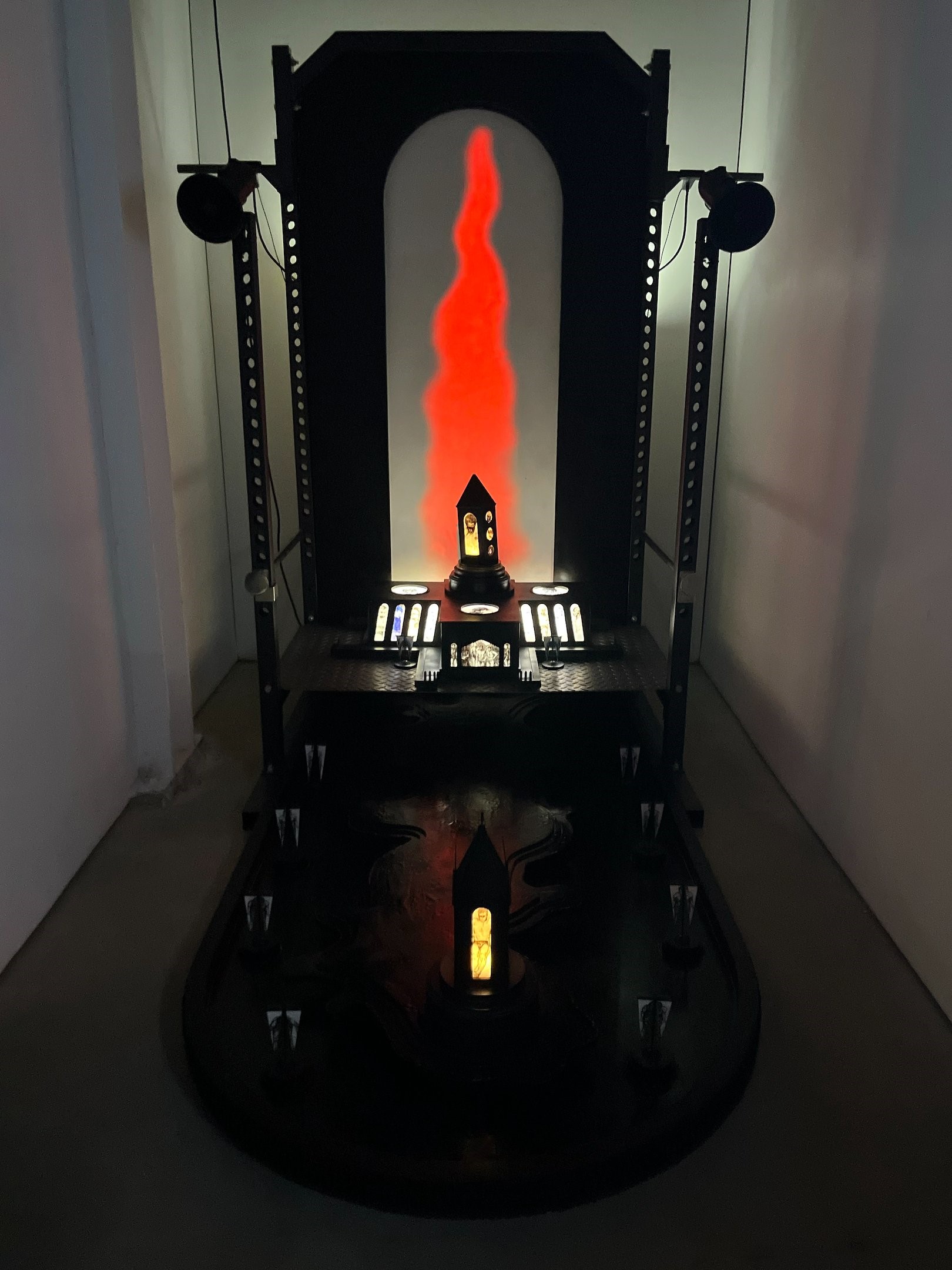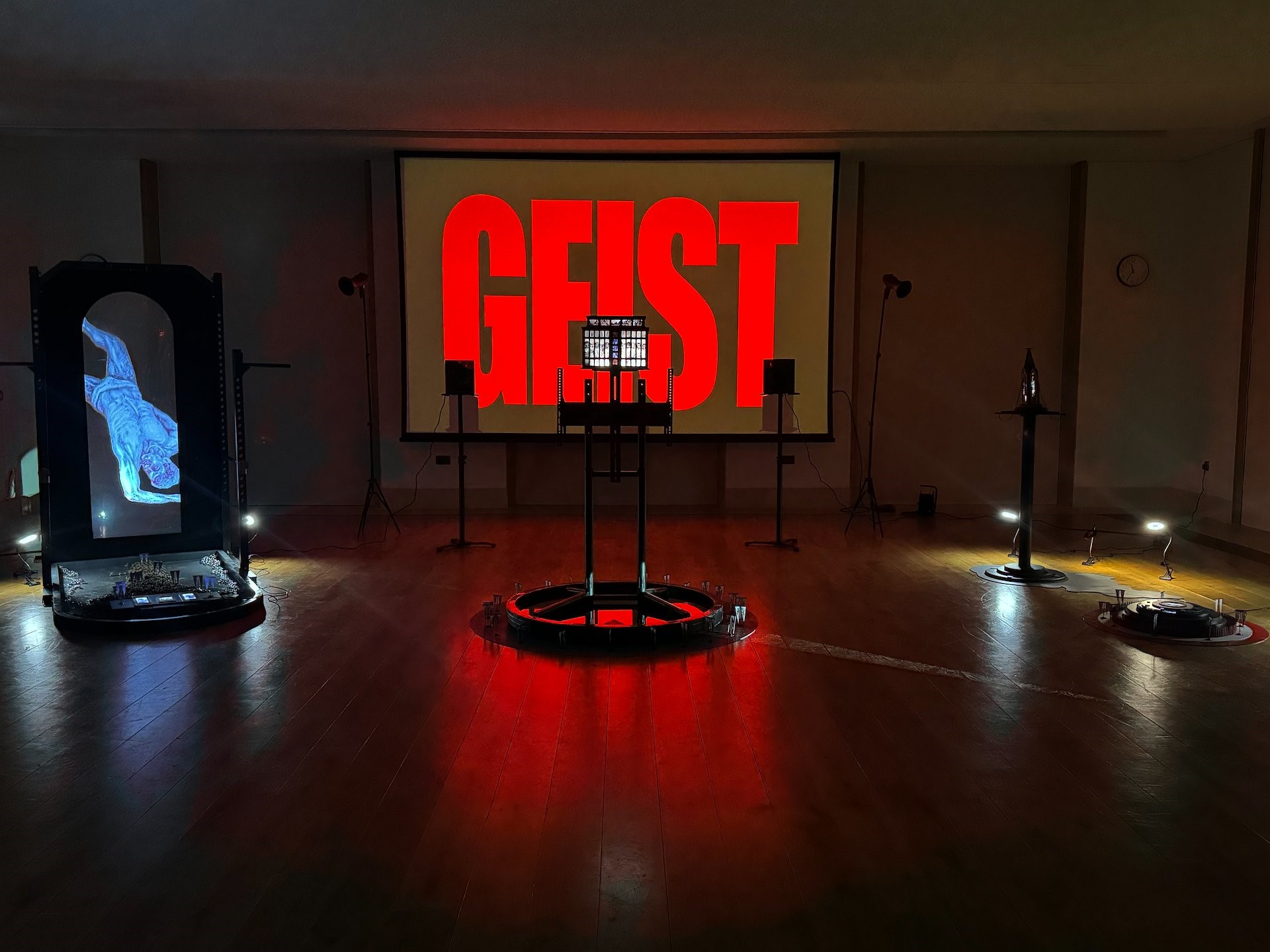Masculinity and Modernity: In Conversation With 2023 Emery Prize Winner William Lowry
ARTICLE |
Anna Mayer, Co-Chair of the Pembroke JCR Art Fund and third-year Philosophy and Theology student, sat down to speak with the artist behind the Art Fund’s current exhibition, Terminus. She writes about their full conversation below.
A multimedia artist and sound designer, recent Ruskin BFA graduate and 2023 Emery Prize winner William Lowry’s work is brutal yet beautiful. Ahead of his solo exhibition ‘Terminus’ in the Pembroke JCR Art Gallery, I spoke to him about his artistic practice, influences and inspirations, masculinity and modernity, and the “destabilising force of the always shifting cultural gaze”.
William’s work employs a plethora of mediums and materials, at the intersection of drawing, painting, print-making, sculpture and sound. His use of materials is ambitious and innovative, utilising industrial steel frames, polythene sheeting, and salvaged car parts, among other ephemera, all in dialogue with small, finely detailed drawings. His masterful synthesis of modern and digital ways of working with the more traditional and tactile speaks to his spectacular versatility. Meditating on masculinity and queer desire, William’s artistic practice interrogates the male body, depicting “sons and lovers, caught in crisis, contemplation, and conflict”, nude and vulnerable – laid bare, literally and figuratively. His hyper-detailed, highly textured drawings are poignant and personal, delicately unfolding intimate moments hidden in edifices and apertures.
A recurring artistic preoccupation for William is the construction of modernity. His work probes questions of identity, masculinity, power, and desire, in dialogue with the “master narratives of the twentieth-century”; self and other, individual and collective, East versus West, and ultimately how these questions “propel and embed themselves in the modernist machine”. William’s art interrogates “the overwhelming sense of dread and apprehension about pre-eminent destruction” as well as the distinctive sense of “disillusionment and alienation” that has characterised the last one hundred years. Depicting astronauts and atomic bombs, among other iconic images, his work signals to the “impossible ideals and hopes for progress, technologically, scientifically and socially, that never truly came to fruition”. His disenchantment with the project of modernity emerges through his ominous, arcane depiction of bodies and structures. In his own words, his work aims to “offer the viewer an isolating, apocalyptic vision of male bodies haunted by a fracturing ideology”.

‘Acheron’, William’s exhibition at the 2023 Ruskin Degree Show and the work for which he was awarded the Emery Prize, is similarly haunted. A confined, darkened space hidden behind a glistening latex abattoir curtain tucked away surreptitiously in the gallery's back corner, ‘Acheron’ centred on a constructed cathedral with backlit windows. “Its elaborate architecture recalled imperial-ecclesiastical structures and triumphal ceremonies”, Lowry tells me, emulating the claustrophobia of a confessional booth and the intimacy of a chapel in the enclosed space, juxtaposed with the grandeur and gravity of the structure at its centre, though made miniature. He describes ‘Acheron’ as a “hellscape” – indeed, in classical myth, Acheron is a river flowing through the gorges of the underworld – though, upon entering the gallery space, I felt as though its dark aesthetic and undulating soundscape were so enchanting it bordered on hedonistic.
William describes his exhibition ‘Zeitgeist’ in November of last year at Trinity College as “a more ambitious expansion of ‘Acheron’s’ aesthetics”. A reflection on research William completed in Berlin, ‘Zeitgeist’ ruminated on the city’s nightlife aesthetics and post-war industrial architecture. A pulsating projection and a sonorous, abrasive original soundtrack acted as the backdrop to a number of ominous, imposing structures sprawled throughout the space, modelled after Berlin landmarks – the Church of Reconciliation, the techno club Berghain.
He describes Berlin as a city that has “faced destruction and reemergence cyclically” and been “forced to continually synthesise its various broken parts into something that works in the contemporary age”. William has a distinctive sense of the way that Berlin as a city is in constant and continual dialogue with its own history – he describes how Berghain was formerly an East German power plant, and thus his depiction of the looming post-industrial icon comments on how the structure has been stripped of its original meaning and “converted into something that fetishises the body and movement”. Amongst “the crisis of meaning created by our digital world”, William tells me, something so “spiritual and bodily and immediate” functions as an antidote. It strikes me that his work is similarly “spiritual and bodily and immediate”.

The gothic splendour of both ‘Zeitgeist’, as well as ‘Acheron’ readily emerge in ‘Terminus’, as a culmination of his work to date. As theatric and immersive as ever, this new body of work will emerge in a familiarly darkened gallery space, permeated with spotlights and music in William’s signature style, as he endeavours “to unite the space and bring together the disparate elements of [his] practice”. Shifting towards more wall-based work, self-contained and stand-alone drawings, paintings and more traditional portraiture will enter into William’s world – “intimate, tangible objects” – while not leaving behind his mesmerising multi-media use of light and sound. Drawing on contemporary and classical aesthetics to invoke existential notions of continuation, protraction and finality, ‘Terminus’ will employ “images of hippodromes, racetracks and amphitheatres” that “call to mind the crumbling vestiges of dead empires and civilisations”, William tells me, “while depictions of wrestlers, soldiers and sportsmen” will “conjure up associations of control, subjugation and domination”.
There is no doubt that William’s work is a feast for the senses: luminescent projections dissecting the darkness, pounding, pulsing soundscapes, fantastically detailed drawings. But these projects are not merely sensory endeavours; they are meditations on institutions and individuals, ideas and innovations. His work is not only theatric, dramatic, and emotive, but deeply incisive and insightful.
William Lowry is the recipient of the 2023 Emery Prize – an annual prize awarded by the Pembroke JCR Art Fund to a Ruskin School of Art, University of Oxford, BFA or MFA finalist. Named after the founder of the Pembroke College JCR Art Collection, the Emery Prize reinvents the collection’s historic links to the Ruskin School of Art, by finding new ways to support contemporary art practice through providing a platform for exhibition.
‘Terminus’ by William Lowry opens on Friday March 1st with a Private View and drinks reception at the Pembroke JCR Art Gallery in the Rokos Quad from 4pm-6pm. The exhibition is then open in the gallery from 11am-4pm daily until Wednesday March 6th, with a Q&A and Live Sound Performance by William Lowry on Sunday March 3rd from 6pm-8pm.
Find out more about William and view his portfolio here: https://williamlowry.portfolio.site/